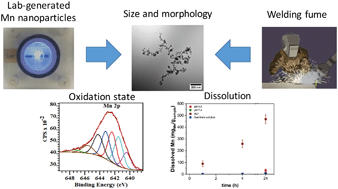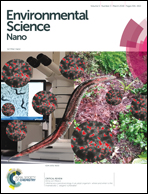Physicochemical properties of air discharge-generated manganese oxide nanoparticles: comparison to welding fumes†
Abstract
Exposure to high doses of manganese (Mn) via inhalation, dermal contact or direct consumption can cause adverse health effects. Welding fumes are a major source of manganese containing nanoparticles in occupational settings. Understanding the physicochemical properties of manganese-containing nanoparticles can be a first step in understanding their toxic potential following exposure. In particular, here we compare the size, morphology and Mn oxidation states of Mn oxide nanoparticles generated in the laboratory by arc discharge to those from welding collected in heavy vehicle manufacturing. Fresh nanoparticles collected at the exit of the spark discharge generation chamber consisted of individual or small aggregates of primary particles. These nanoparticles were allowed to age in a chamber to form chain-like aggregates of primary particles with morphologies very similar to those from welding fumes. The primary particles were a mixture of hausmannite (Mn3O4), bixbyite (Mn2O3) and manganosite (MnO) phases, whereas aged samples revealed a more amorphous structure. Both Mn2+ and Mn3+, as in a double valence stoichiometry present in Mn3O4, and Mn3+, as in Mn2O3 and MnOOH, were detected by X-ray photoelectron spectroscopy on the surface of the nanoparticles in the laboratory nanoparticles and welding fumes. Dissolution studies conducted for these two Mn samples (aged and fresh fume) reveal different release kinetics of Mn ions in artificial lysosomal fluid (pH 4.5) and very limited dissolution in Gamble's solution (pH 7.4). Taken together, these data suggest several important considerations for understanding the health effects of welding fumes. First, the method of particle generation affects the crystallinity and phase of the oxide. Second, welding fumes consist of nanoparticles with multiple oxidation states, whether they are amorphous or crystalline, or occur as isolated nanoparticles or agglomerates. Third, although the dissolution behavior depends on the conditions used for nanoparticle generation, the dissolution of Mn oxide nanoparticles in the lysosomal fluid may promote Mn ion translocation into various organs causing toxic effects.

- This article is part of the themed collections: Nanomaterials in air and Celebrating Excellence in Research: 100 Women of Chemistry


 Please wait while we load your content...
Please wait while we load your content...